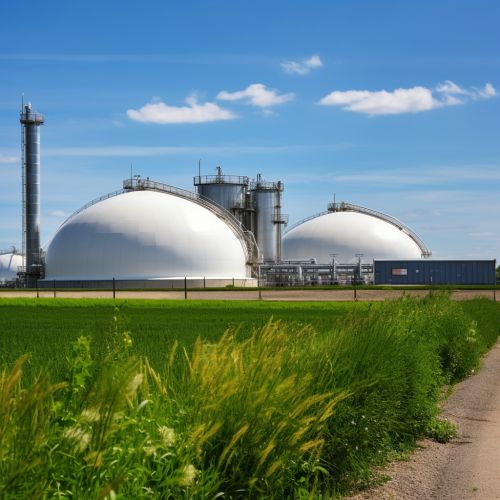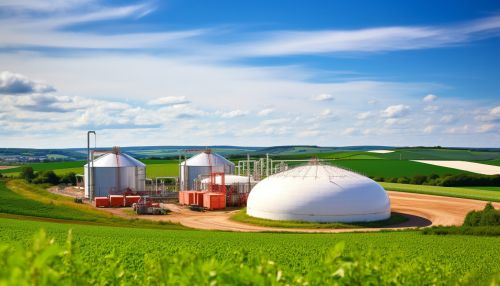Anaerobic Digestion
Introduction
Anaerobic digestion is a series of biological processes in which microorganisms break down biodegradable material in the absence of oxygen. It is used for industrial or domestic purposes to manage waste or to produce fuels. The process is used in the management of waste material in industries such as brewing and food and drink production, as well as for domestic waste management and the production of biogas.


Process
The process of anaerobic digestion involves four key stages: hydrolysis, acidogenesis, acetogenesis, and methanogenesis. The overall process can be described by the chemical reaction, where organic material such as glucose is broken down into carbon dioxide, methane, and water.
Hydrolysis
In hydrolysis, bacteria break down the complex organic molecules into simple sugars, amino acids, and fatty acids. This is achieved through the production of enzymes that can break down the complex molecules. The rate of hydrolysis is dependent on the nature of the feedstock.
Acidogenesis
The simple molecules are then further broken down in the acidogenesis stage to volatile fatty acids with additional formation of ammonia, carbon dioxide, and hydrogen sulfide. This stage is also facilitated by bacteria.
Acetogenesis
In the acetogenesis stage, the volatile fatty acids are further broken down into acetic acid, along with additional ammonia, carbon dioxide, and hydrogen. This stage is facilitated by acetogenic bacteria.
Methanogenesis
The final stage of anaerobic digestion is methanogenesis. Methanogens, a group of archaeal microorganisms, convert the acetic acid into methane and carbon dioxide. This stage is sensitive to environmental conditions and can be inhibited by a number of factors, including temperature, pH, and the presence of certain chemicals.
Applications
Anaerobic digestion has a number of applications in various industries, including waste management, renewable energy production, and agriculture.
Waste Management
In waste management, anaerobic digestion is used to reduce the amount of organic waste going to landfill, thereby reducing the emission of greenhouse gases. It is used in the treatment of a wide range of waste streams, including municipal solid waste, food waste, and sewage sludge.
Renewable Energy Production
Anaerobic digestion is also used in the production of renewable energy. The biogas produced during the process can be used to generate heat and electricity, or it can be upgraded to biomethane and used as a renewable natural gas substitute.
Agriculture
In agriculture, anaerobic digestion is used to process animal manure and crop residues, producing a nutrient-rich digestate that can be used as a soil conditioner or fertilizer, as well as biogas that can be used for energy production.
Advantages and Disadvantages
Anaerobic digestion has several advantages and disadvantages that need to be considered when evaluating its use.
Advantages
One of the main advantages of anaerobic digestion is that it reduces the emission of greenhouse gases, particularly methane, which is a potent greenhouse gas. It also produces a renewable source of energy in the form of biogas. The process also produces a nutrient-rich digestate that can be used as a fertilizer, reducing the need for synthetic fertilizers.
Disadvantages
However, there are also disadvantages to anaerobic digestion. The process requires a significant amount of energy to maintain the necessary conditions for the microorganisms to function effectively. It can also produce odors if not properly managed. Additionally, the digestate produced can contain pathogens and heavy metals, which can be harmful if not properly treated.
